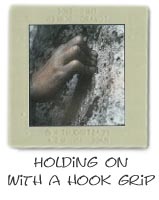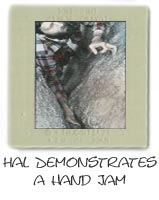|

|
Ten stories above Mike, I was nearing the hardest move on the climb, the part that climbers call "the crux." The rock got steeper and smoother, and the holds grew scarcer. There seemed to be no hand or foot holds. The crack I had been following pinched down to a thin seam. My fingertips searched across the blank rock to my left, feeling nothing at first. Finally, they found a rough spot suitable for use as a foothold. My fingertips are capable of feeling a groove or surface roughness only one ten thousandth of an inch deep. Here, on the cliff, my sense of touch had found a hold that was too well camouflaged for my eyes to see. Climbers need a good sense of touch. The calluses that a climber develops from continual climbing interfere with this sense of touch, which is why some top climbers can be seen sitting around the campfire sanding their calluses away like safe crackers in an old B-movie. |
|
One terrible foothold was not going to get me up over the next stretch of steep rock, so l continued groping for a better hold. There was a small spot in the crack, wide enough to take two fingertips, so l put two fingers into the hole. Bad news-it was wet. Moist skin has a better grip than dry skin. (That's why loggers spit on their hands before wielding an axe, and is one reason that my fingertips have sweat ducts.) Too much moisture, however, acts as a lubricant. Unfortunately, I was in a tight situation, and my palms and fingertips had begun sweating in response to emotional pressure. The last thing I wanted to do right now was to add my sweat to the wetness of the crack. It was wet enough. My fingertips have papillary ridges, which make up my fingerprints. Like the tread on a car tire, these fingerprint ridges improve the friction of my grip, but not enough to get me past the wet section of the climb. Some climbers carry a small bag of gymnast's powdered chalk with them. A quick dip of their hands into the chalk dries the hands, and coats them with a thin layer of abrasive material which improves their grip. At that moment, I almost wished I was a climber who was willing to use chalk. I kept looking around for better holds, but my search was fruitless. I was going to have to move up on the friction of a poor foot smear and the pull of two fingertips jammed into a small, wet hole. My last protection was just below my feet. I put my fingers in the hole, stepped up with my foot, and pulled. My fingers began to ooze out of the crack, so I quickly lowered myself back to see if I could find some more holds. Mike patiently held the rope and shouted encouragement. After all, if I couldn't lead the crux, he would have to. Climbing exerts tremendous forces on fingers. I remembered when my friend Hal was doing a two-finger layback, just like the one I was about to try. (In a "layback," a climber pulls himself into a hold on a steep wall with his hands and then walks up the wall.) One of Hal's fingers slipped off the hold. Suddenly, the remaining fingertip was loaded with most of Hal's weight. He heard a loud "Kapow!" as the tendon that connected the muscle to the fingertip of his middle finger ripped, and he fell. |
|
A doctor found that the tendon was only partially ripped. For two weeks,
Hal's finger ached. It was six weeks before he could brush his teeth without
noticing the weakness in the last joint of his finger. It was over a year
before his finger had recovered its pre-accident strength. Tendons heal
slowly.
My mind wandered while my fingers searched for a hold. I thought about my fingers. A lever operates at a mechanical advantage It can amplify a few pounds of force moving over a large distance into a large force moving over a small distance Fingers, however, operate at a mechanical disadvantage The tendon connecting the bone of the fingertip to the muscle in the arm must pull with a strong force to resist a small force applied to a fingertip. The one hundred pounds exerted on Hal's fingertip was amplified to several hundred pounds of tension in Hal's finger tendon and muscle That was enough force to rip the tendon. |

|